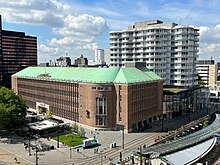
The Rotterdamsche Bank, known from 1911 to 1947 as Rotterdamsche Bankvereeniging or Robaver,[1] was a significant bank in the Netherlands, founded in 1863. In 1964, it merged with Amsterdamsche Bank to form AMRO Bank (for AMsterdamsche & ROtterdamsche).[2]
Overview[edit]
The Rotterdamsche Bank was established on 16 May 1863 by a group of businessmen and bankers, who took inspiration from the British Colonial Bank and aimed at financing trade and investment in the Dutch East Indies. After a difficult start, however, the bank soon focused on domestic business.[3]
Between 1911 and 1947 it was known as the Union Bank of Rotterdam (Dutch: Rotterdamsche Bank Vereeniging, abbreviated as Robaver), following its 1911 acquisition of Rotterdam competitor Deposito- en Administratie Bank (est. 1900) and soon afterwards of Amsterdam brokers Determeijer Weslingh & Zn. (est. 1765). Under the leadership of its ambitious managing director Willem Westerman, it went on to acquire a number of local banks,[4] but became overextended and had to be restructured under the aegis of De Nederlandsche Bank in the mid-1920s. In 1928, it created the Vrouwenbank ("Women's Bank"), a bank targeted at a female customer base that lasted until 1971.[4]
In 1960, Rotterdamsche Bank acquired Nationale Handelsbank, a major former colonial bank that had been known until 1950 as the Dutch-Indian Trade Bank (Dutch: Nederlandsch-Indische Handelsbank, NIHB; est. 1863).[3]
-
Pre-World War II Rotterdamsche Bank head office on the Boompjes waterfront thoroughfare, ca. 1905
-
Branch on Rokin in Amsterdam, 1979 (demolished since then)
-
Former branch building at Kneuterdijk 8, The Hague
See also[edit]
References[edit]
- ^ a b "Rotterdamsche Bank". Post-war reconstruction Community Rotterdam.
- ^ "Bigness Sought by Dutch Banks; Merger of 4 Units Into Two Aimed at Competition". New York Times. 6 July 1964.
- ^ a b ABN AMRO Historisch Archief, Rotterdamsche Bank, 1863-1964 (PDF)
- ^ a b "Our History". ABN Amro.
![Pre-World War II Rotterdamsche Bank head office on the Boompjes [nl] waterfront thoroughfare, ca. 1905](https://upload.wikimedia.org/wikipedia/commons/thumb/7/75/De_Rotterdamsche_Bank_bij_de_Boompjes_1903_-_1907.jpg/86px-De_Rotterdamsche_Bank_bij_de_Boompjes_1903_-_1907.jpg)


![Former branch building [nl] in Gouda](https://upload.wikimedia.org/wikipedia/commons/thumb/3/3b/Rotterdamsche_Bank_Oosthaven_Gouda.jpg/120px-Rotterdamsche_Bank_Oosthaven_Gouda.jpg)
Well, that’s interesting to know that Psilotum nudum are known as whisk ferns. Psilotum nudum is the commoner species of the two. While the P. flaccidum is a rare species and is found in the tropical islands. Both the species are usually epiphytic in habit and grow upon tree ferns. These species may also be terrestrial and grow in humus or in the crevices of the rocks.
View the detailed Guide of Psilotum nudum: Detailed Study Of Psilotum Nudum (Whisk Fern), Classification, Anatomy, Reproduction